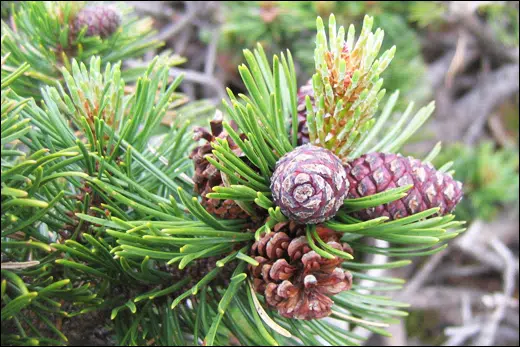Pinus Mugo Turra / Mountain Pine – Classification, Ayurvedic Properties & Dosage
Description
Pinus mugo turra is also known as mountain pine / dwarf mountain pine, is an evergreen small tree or shrub or erect bush growing up to 4.5m (14ft) by 8m (26ft) at a very slow rate 2-3m per year. It is the most slow growing tree species in Europe. The species’ maximum age is about 250–300 years. It has spreading stems and can spread up to 10m. This dwarf mountain pine is more tolerant to cold climates than other European pines. It has an extensive root system with many branches that holds loose soil thus preventing torrents and avalanche erosion on high mountains. It also acts as a bio-indicator for air quality monitoring. Pinus mugo turra is also an ancient herb, traditionally used for medicinal purposes for example in Romanian folk medicine, the leaf buds of Pinus mugo turra were used as a diuretic and antiseptic in urethritis and cystitis and as an anti-inflammatory in respiratory diseases in the form of infusion. In Europe, supplements are being made from the bark of pine which is rich in phytochemicals that are known to prevent many diseases.

Taxonomical Classification
- Kingdom – Plantae
- Phylum – Tracheophyta
- Class – Pinopsida
- Order – Pinales
- Family – Pinaceae
Synonyms
- Mountain pine (common name)
- Dwarf Mountain-pine
- Mugo pine
- Dwarf Mugo Pine
- Scrub mountain pine
- Swiss mountain pine
- Scots Pine
- Planinski bor (Bosnian)
Other Local Names
- French – Pin de montagne
- German – Berg-Föhre
- Italian – Pino montano
Chemical Composition
- Essential Oil: α-pinene (10–30 %), β-pinene (3–14 %), δ-3-carene (5–25 %), p-cymene (trace-2,5 %), limonene (8–14 %), terpinolene (1–8 %), bornyl acetate (1–5 %), (E)-caryophyllene (0.5–5 %), myrcene (3–11 %) and β-phellandrene (8–17 %)
- Phenolic Acids: Quinic acid and p-coumaric acid
- Procyanidins: Catechin
- Flavonoids: kaempferol, myricetin, quercetin, laricitrin and isorhamnetin
Distribution And Habitat
Dwarf mountain pine scrub generally occurs in the mountainous region of Central and Eastern Europe at elevation of about 2000 to 2700m, and grows abundantly in the subalpine belt of the Eastern Alps and the Carpathians between elevations of about 1600 to 2200m.
The dwarf mountain pine requires very less water, high atmospheric humidity and a lot of sunlight to grow. It spreads over free-drained and low nutrient substrata, which lack nitrogen. Its main habitat is in massive fissured bedrock (such as limestone, dolomites, sandstone, gneiss and granite), block fields, alluvial fans and sand dunes. It can grow at the optimum temperature of about 5-35°C.
Practical Uses And Benefits
- External Uses
- Essential oils extracted from cones, needles and twigs of Pinus mugo turra are used in liquid soaps and fragrant bath oils, detergents, woody perfumes and household cleaning supplies.
- Resin obtained from this shrub contains turpentine and has diuretic and rubefacient properties.
- It is also used for rubbing and steam bath effective in treatment of rheumatism.
- It is very beneficial for the treatment of a variety of skin conditions, wounds, burns sores, boils etc and is used in skin dressings.
- Internal Uses
- Pinus mugo turra is very beneficial to the respiratory system and its problems such as cold, cough, influenza and tuberculosis and so is helpful in treating problems of the mucosal linings.
- Needles of the dwarf mountain pine are rich in vitamin C, thus consumed as a beverage to enhance the general immune system.
- It is also used for kidney and bladder general health.
- The apical branches are antiasthmatic, expectorant, balsamic and good for heart muscles.
- In the food industry, parts like shoots are used for imparting flavor in dishes.
- Other Uses
- Essential oil extracted from the leaves of mountain pine exhibit antioxidant activity and used as preservatives for food to prevent spoilage and rancidity.
- The role of Pinus mugo turra in soil erosion control and water conservation is of primary importance in the high-mountain belt.
- A tan or green dye is obtained from the needles used to dye fabrics.
- Mountain pine wood is used for manufacturing of different artifacts because of its hard but elastic wood and valued as much as fuel.
- Resins are obtained from the buds of mountain pine used as varnishes and adhesives.
- It is used in gardens and parks as a decorative plant.
- Researchers also showed that essential oils of Pinus mugo turra also exhibit bio-pesticidal activity in liquid or vapor phase.
Part Used
Flowers, buds, needles, shoots and cones
Dosage
- Essential Oil : 0.1 – 0.2ml
- Extract : 0.2 – 0.3ml
- Powder : 14 – 16 mg
Resins obtained from the buds of the shrub can cause dermatitis in sensitive people.
Similar Indian Ayurvedic Herb
| Herb Name | Scientific Name | Benefits | Effects On Doshas |
| Sarala/Chir pine | Pinus roxburghii | Asthma, bronchitis, remove sputum from respiratory passages has diuretic activity. | Vata and Kapha balancing properties |
Further research is going on to explore more about Pinus mugo turra (Mountain pine) application for its exploitation in various fields. There is a need to compare this pine species with its other allies so as to gain consciousness about its unique features or benefits that one can not take from the other herbs present.



